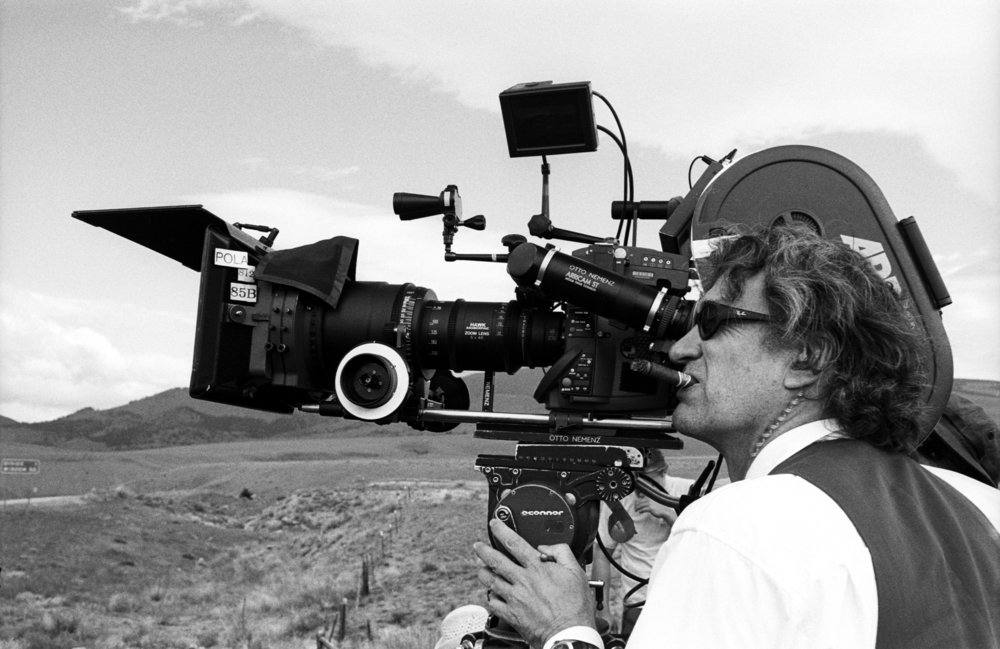
Pioneer of the New German Cinema movement in the 1970s, respected German film-maker Wim Wenders has pronounced that iPhone photography is not really photography at all. He has a point, even though I don’t entirely agree with him.
In a BBC Radio 4 interview, Wim says that the trouble with iPhone pictures is that nobody sees them. He maintains that even the people who take the pictures don’t look at them any more, and certainly don’t make prints.

Instant gratification
It’s clear to me that the whole social media scene, with easy manipulation of shots for instant gratification, and the transient nature of most smartphone photography (not that a lot of “proper” photography doesn’t fall into the same trap) is the antithesis of traditional creative photography. The careful, thoughtful composition, the honing of a few chosen shots, the printing, the presenting, the exhibiting, all of this is alien to the modern smartphone photographer.
This is not, however, necessarily a bad thing. Some photographers (and some camera manufacturers) have complained in recent years that the smartphone has killed/is killing the traditional camera. To an extent, this is true because the smartphone is a far more convenient and usable snapshot camera than the last generation of point-and-shoot devices. When everyone has a smartphone in their pockets, why bother with a separate device that possibly produces inferior results? The smartphone has killed the low-end of the camera market but this was inevitable and has been clear for the past ten years.

Persuasion
Fortunately, other areas are doing well, particularly the new genre of high-end (and expensive) mirrorless compacts and system cameras. The reason for this is that the smartphone is actually supporting the camera industry. The iPhone produces undeniably excellent results with very little manual input from the user; I’ve often said that it flatters to deceive. But what it does do is persuade a whole new generation that they could be better photographers. More people than ever are taking photographs and, whether we like it or not, they are all photographers. Most important, though, is that a significant proportion of smartphone photographers soon start thinking about something better: A proper camera. It doesn’t have to be a big percentage when you consider that billions of smartphones are in use as cameras.
While I agree with Wim that the majority of iPhone output is not true photography in the general sense, it is putting new life into the world of photography. People who have talent discover that by using their phone and generating a strong passion go on to support the camera industry. They will become the next generation of talented amateurs and professionals.
In this sense, it can be argued that the iPhone has been the saviour of photography. It is the most successful Trojan horse the photography industry could have dreamed of.
What do you think? Is Wim Wenders on the ball or do you believe the smartphone is our best recruiting agent?
_________
- Subscribe to Macfilos for free updates on articles as they are published
- Want to comment on this article but having problems?






There is nothing to do with the device. I have pictures taken with my iPhone on my website and like them the same.
I agree.
What’s a photograph?
I use several cameras and I use my iPhone! It’s about the picture, not the device. I also print my iPhone photos, a lot of them on Mini and Square Fuji Instax printers.
I have shot some fantastic images on my iPhone 7 Plus. Some are amazing and look the dogs. Others are questionable.
I’m good light and most normal circumstances a phone is fine. And that meets most people’s needs.
For those of us who have more specific need, or who want a different output then our cameras are the right tool for the job.
I look around my dining and living rooms, all of the canvases and prints that hang in frames are either shot on Nikon or Leica, so that says it all, none of my phone shots meet that quality test for me yet.
Dave
… They all laughed at Christopher Columbus
… When he said the world was round
… They all laughed when Edison recorded sound
… They all laughed at Wilbur and his brother
… When they said that man could fly
…. They told Marconi
… Wireless was a phoney
… It’s the same old cry!
… They all laughed at Barnack’s little Leica
… But it proved it’s quite a
… Innovative blighter
… So Ho Ho Ho !
… Oscar’s got the last laugh now!
… They all laughed at Smarty Phoney Cameras
… Wot a load of shammerers!!
… But Huawei’s proved
… Leica lens in ‘THREES’
… Is the ‘BEES KNEES’
… So Dr Kaufmann’s laughing now!
Ha ha ha read this, and nearly laughed out loud, my wife is now looking at me funnily.
Dave
I am sixty plus and use a Leica (film and digital) and Rollicord. I have just used an iPhone 6s for a uni project I am doing (photography degree). It was perfect for the use I needed for and up printing was fine. You obviously don’t have the full range of exposure options (yet) over a digital Leica and nothing beats putting a roll of film into the Rollei. But, in the end, the camera phone will replace the low end of compact cameras for most and probably be the goto camera for many. It’s evolution.
I reckon that the camera on the pocket phone is good enough for many people.
For some though it lends more to telephony than to photography since they use it as an extension of their conversation… here’s a picture of medinner 😄, or some such. A way of illustrating conversation. Photeversation? So it could be argued that it brings something extra, whether that is desirable is another matter. It is plausible that the more pictures there are in a conversation, the less interesting the words become, leading to a hit on the quality of written and spoken language.
Wenders also contends that you don’t have something to remember the event, something to hold, so he isn’t just digging out phones, he is talking digital too. The reality is that many of us who use film, go on to digitise it, so even though the default position is to have something to hold, or shove in the suitcase under the bed (for that McDonalds moment), we end up in the same position as the person with the phone. It’s all in one cloud or other… real ephemera.
So I sort of disagree with the old lefty, I reckon that the iPhone adds to photography, it’s just that the camera makers have not kept up with the zeitgeist, apart from Leica who have teamed up with Way-Hay or whatever. ’tis a good move though.
I think that Mr Wenders is confusing photography (the making of photographs) with the ‘photographic industry’, such as it is nowadays, which includes both manufacturers and professional photographers. Any image relying on light or light sources for its origins and made by a human being, with whatever device, is a photograph. There is no disputing that. Again on the same tack, an image made in a family group in a bar or a restaurant is just as valid as a true photograph as one made in a studio by a professional photographer using so-called ‘high end equipment’.
Wenders has a great interest in ‘photography as art’ in respect of both moving and still images and we must respect him for that. The paradigms about photography and image making have, however, been completely re-written since the first digital cameras appeared. Allied to this, is the great explosion of channels where digital images can be used, such as social media, which did not exist to any great extent just 15 or so years ago.
We should not really care about camera manufacturers as they have had a great deal of ‘fair warning’ about such matters and have failed to respond in any meaningful way, leading to huge declines in the sales of stand alone cameras. I feel that we have not seen the end of this and other means of digital capture of light are coming down the tracks which may replace everything that has happened so far. The concept of a light tight box for 35mm (now so-called ‘full frame’ digital) format or variants with interchangeable lenses goes back to Herr Barnack’s and other’s work in the late 1920s and early 1930s and I am astonished that we are still using basically the same layout late in the second decade of the 21st Century.
As for Mr Wenders, I believe that he ‘ain’t seen nothin’ yet’.
William
Not actually true. I am a senior photographic judge covering photographic societies competitions over much of the south of England and I not only do see prints done from Smartphones but as far back as two years ago gave first and second places in a major competition with hundreds of pictures entered to what turned out to be the same entrant, and he came up afterwards and said ‘Do you know I do not even own a camera’
It might surprise some but although I am a very seasoned and long term traditional photographer (but smartphone wimp) this in fact pleased me no end. Why? Well because pictures are taken between the eyes and whatever they are taken with is just a tool, so although I will not be joining them, well done to the smartphone generation as I suspect it is photography’s future.
"These darned glass plates and as-many-prints-as-you-want negatives will be the death of the Daguerrotype.."
"This darned Kodak roll film and Box Brownie will be the death of photography, and wet collodion glass plates.."
"This darned 35mm movie-film Leica "miniature camera" will be the death of photography, and the Graflex newspaper cameraman.."
"This darned ‘digital’ SLR with an electronic chip inside will be the death of proper photography, and of ‘proper’ 35mm film.."
"These darned mobile phones with cameras inside will be the death of ‘proper’ digital photography.."
You really nail the sterility of the generalisations in an amusing way.
My initial response was to think I should get my ten-year old granddaughter to do an article for macfilos ! She uses her smartphone really to SEE the world around her, both scenically and macro-wise. And she can give an account of what she was after. I don’t know whether she will ever have a "real camera", but she can already turn out interesting and beautiful images.
Hi Mike.. on one hand I hear it is not important if you have the latest camera. A good photographer can take pictures regardless. In other hand here we have someone not appreciative of a certain device or way of taking pictures. It might be true that iPhone pictures don’t get printed but same is the case with pictures I’ve taken with Sony A7RIII or RX1R. I’ve printed only a few and mostly circulated them on emails and Facebook. The technology allows us more freedom. It is upto is how we use and consume it. Yes maybe there was more satisfaction in taking analogue pictures and then developing and printing. But that was also the limitation at the time.